Your Cart is Empty

Intimidated by paddle board yoga? Don’t be. There’s no doubt you’ve seen the stylish pictures of SUP yogis on your Insta feed, rocking bright-colored leggings while practicing yoga on some of the most beautiful waters in the world. You have to admit, it looks like a lotof fun - but it might also look difficult to an untrained eye. Here’s the big secret: it's not nearly as hard as it looks! SUP yoga is a skill that almost anyone can learn, and it’s a wonderful way to reconnect with your body andsoul.
In this article, we’ll demystify SUP yoga step by step. We’ll explain:
If you already like practicing yoga on land, you’ll take to SUP yoga quickly with some patience and a few simple adjustments. But even if you’ve never tried yoga before, you’re bound to have a great time trying out SUP yoga. Just get to know the poses in this article so you have a few basics under your belt, and bring an open mind. You’ll adjust to floating downward dog before you know it!
Whether you’re looking to dive deeper into a mindfulness practice, burn some calories, or get more in touch with nature, SUP yoga has benefits that just about everyone can enjoy. So let’s do some warm-up stretches, dip our toes in, and get started.
Topics Covered in this Article
Paddleboard yoga has so many joys to offer. Here are just a few reasons to get started.
Science is one our side here: there are plenty of research-backed benefits of making SUP yoga part of your routine.
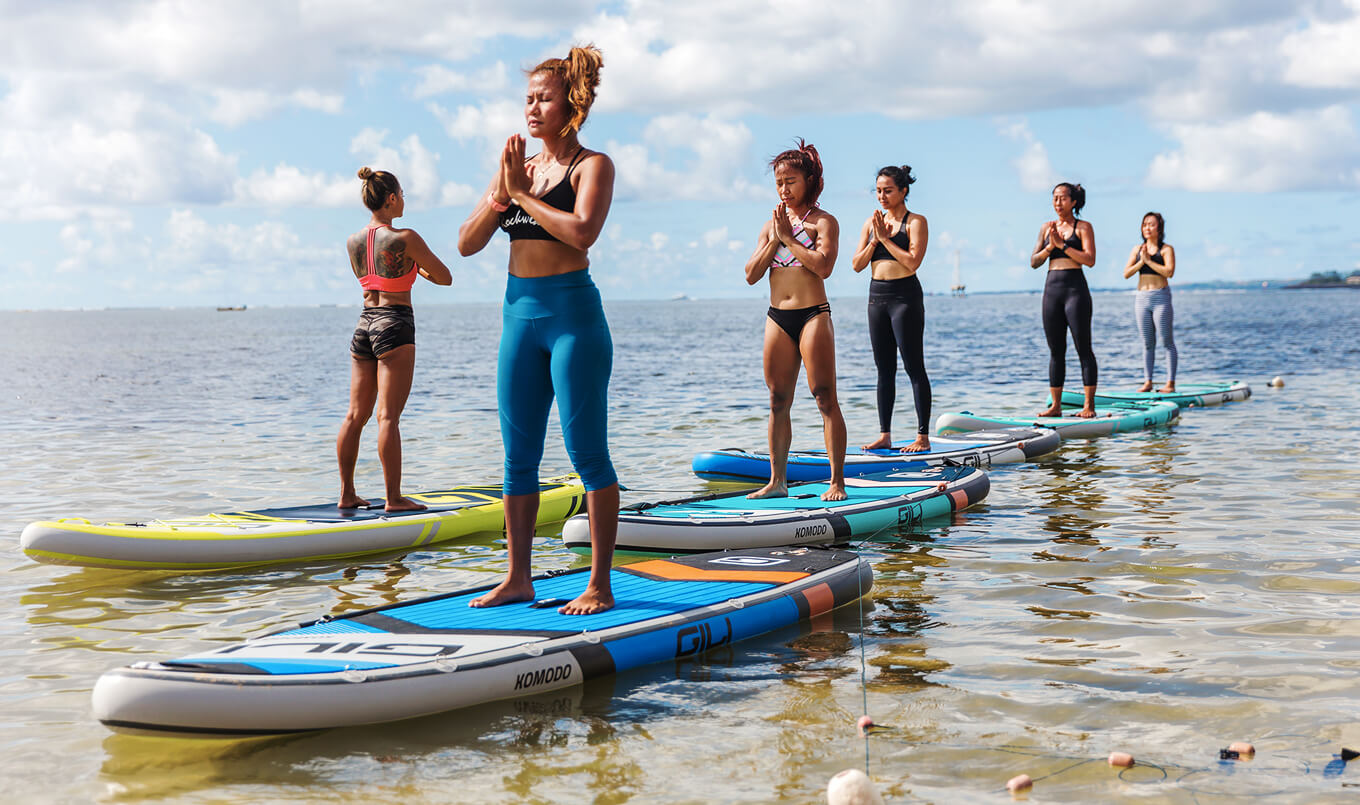
Traditional yoga (on land) and SUP yoga aren’t as different as you’d think, but it does take some adjusting when you first give it a try.
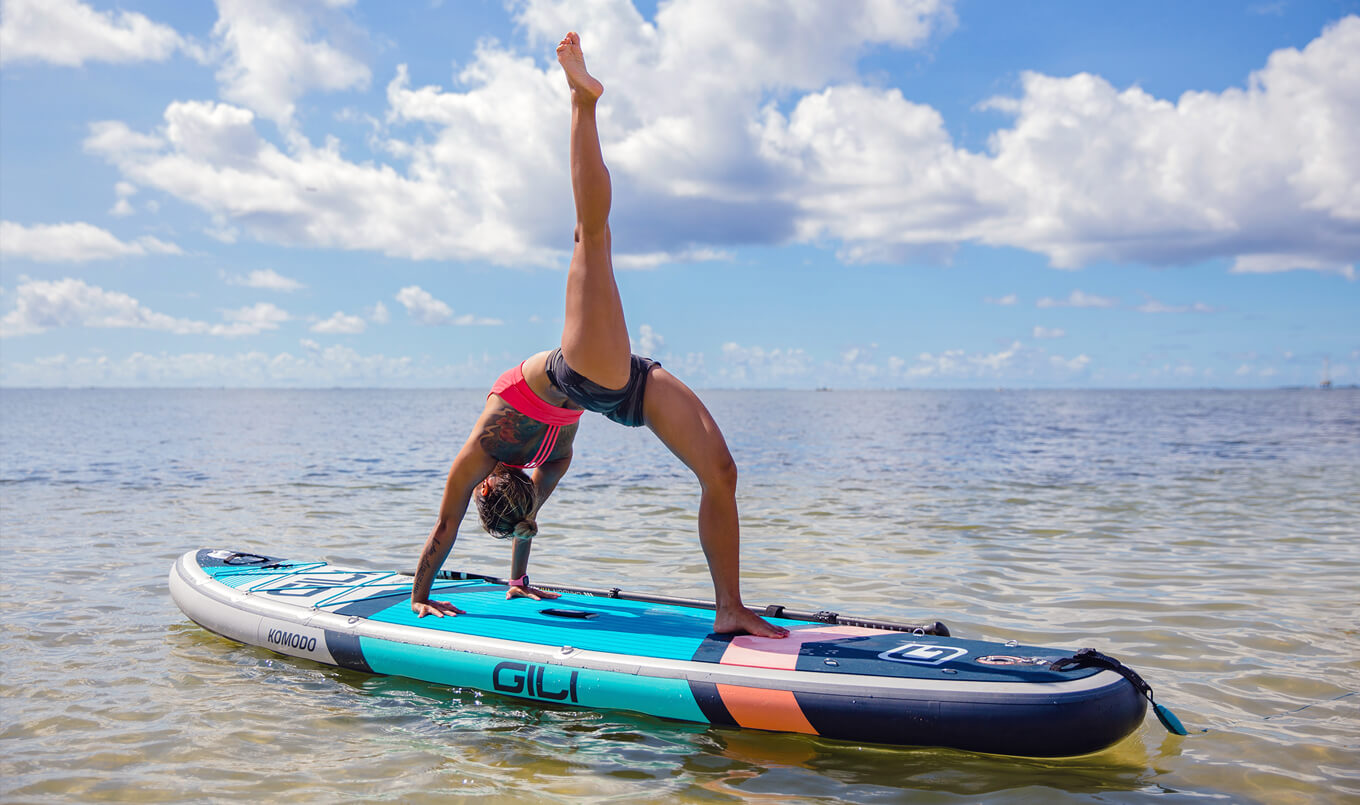
Paddle boards for yoga have special gear needs, and they’ll need to be tethered or anchored as you practice. Before heading to that first SUP yoga class, make sure your board is fully outfitted and ready to go. Although nearly any SUP can be used for yoga, look for a wide, stable board with an extra large, soft traction pad. Learn more about choosing a paddle board.
A securely tethered board keeps you stable and in place during your SUP yoga session. You don’t need to be tethered, but some people find it distracting to be drifting during their routine. There are several ways to tether your board, which we’ll cover shortly.
Any adjustable SUP paddle will do great for SUP yoga - just make sure you have a place to store your paddle when you’re moving through your poses. Some boards, like the 10'6 Komodo, have special paddle holders for this exact purpose. Otherwise, you can store your paddle in your board’s bungees, or wrap your leash around the paddle in order for it to float behind you.
A personal flotation device (PFD) is so important in case of an emergency. We suggest getting a compact PFD to wear around your waist.
Emergency whistles can save the day in a situation where you need to call for help. Keep yours close at hand - many paddlers like to keep them attached to their PFD.
A dry bag can keep your phone and an extra set of clothes secure and dry. Lots of yogis like to dress in layers, and a dry bag is perfect for stashing any layers you take off in the middle of yoga class.
Bring extra bungees or straps to your board for an extra option to hold your paddle, a water bottle, or any other gear you’d like to keep close by but out of your hands.
Keep your SUP secure during yoga class with an anchor, tether line, or floating dock. Although not necessary, your board should be tethered to something so you don’t float away in the middle of your practice. A great option is a Paddle Board/Kayak Anchor, which is used to keep your SUP in place when you're far away from any tie-up points. Other SUP yogis like to attach their boards to a tether line using d-ring clips, a SUP leash, bungees, or a strap. Just make sure whatever you use is strong and secure!

Make sure you also have a paddle board leash so you don’t get separated from the board if you fall into the water while on the board. You can also use your leash to tie up your paddle while practicing yoga.
With these quick tips, you’ll feel like a SUP Yoga pro quicker than you can say “savasana”.

Take note of the most common SUP yoga poses before hitting the water so you have a framework. First things first: child’s pose, or balasana, is an important neutral pose when practicing yoga. It is your grounding point, and the pose you will start most classes from. If at any time during class you feel overwhelmed, in pain, or just in need of a rest, feel free to return to child’s pose and rest there for as long as you need to.
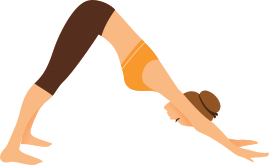 |
Downward Dog (Adho Mukha Shvanasana) One of the most common yoga poses, downward dog, calms your body while strengthening your arms, legs, and shoulders. |
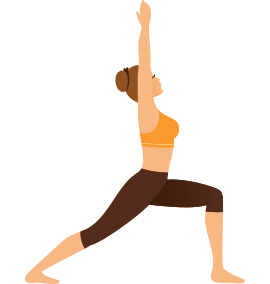 |
Warrior I (Virabhadrasana I) This standing pose helps you feel strong, focused, and powerful. It strengthens your legs, back, and your abs. |
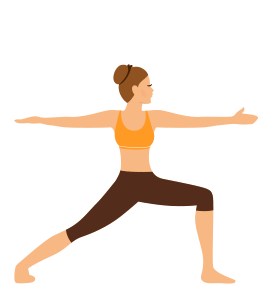 |
Warrior II (Virabhadrasana II) Warrior II is a wonderful hip and inner thigh strengthener. It benefits both your upper and lower body. |
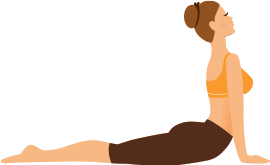 |
Cobra Pose (Bhujangasana) Cobra pose will stretch your shoulders and chest, build flexibility in your back, and lift your mood. |
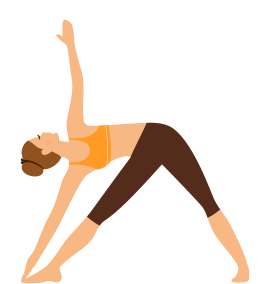 |
Revolved Triangle Pose (Parivrtta Trikonasana) Revolved triangle is a pose to try after you have a bit of SUP yoga experience under your belt. It’s great for improving flexibility, balance, and hip strength. |
 |
Boat Pose (Navasana) This pose involves a seated position, with the legs extending upward at an angle. It’s excellent for balance and hip strength. |
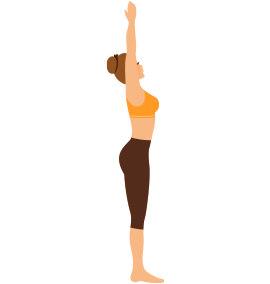 |
Mountain Pose (Tadasana) This exuberant pose is powerful for your legs and arms. |
 |
Pigeon Pose (Eka Pada Rajakapotasana) Pigeon pose is an incredible hip opener and provides a sense of calm. Take great care that you don’t feel any pain or pressure on your knees during this pose, and if it feels uncomfortable stop and ask a yoga instructor for help. |
 |
Camel Pose (Ustrasana) Ease gently into camel pose to strengthen your backbend and stretch the front of your body. This pose is known to induce joy! |
 |
Chair Pose (Utkatasana) Most yogis dread chair pose (hello, burning thighs), but you’ll certainly feel good when it’s over! It’s great for strengthening your quads. |
 |
Corpse Pose (Shavasana) This relaxing, healing pose is usually done as the very last move in a yoga class. You’ll feel calm throughout your body and may experience a meditative effect. Some people consider savasana their favorite part of yoga class, and once you try it, you’ll see why. |
Most All Around stand up paddle boards can be used for SUP yoga. That said, there are some paddle board features will make SUP yoga easier, so put them on your radar before choosing a board.
Take a look at our favorite yoga friendly paddle boards below.
Features:
The 10'6 Komodo, our most versatile board, is wide enough (33") for yogis to practice freely. The paddle holder ensures your paddle won’t go rogue and float away during downward dog, and the full-length traction pad and removable bungee system is perfect for yoga. Capture your moves with the integrated action camera mount. This board is also great for those of you with dogs or like to bring an extra paddler on board.
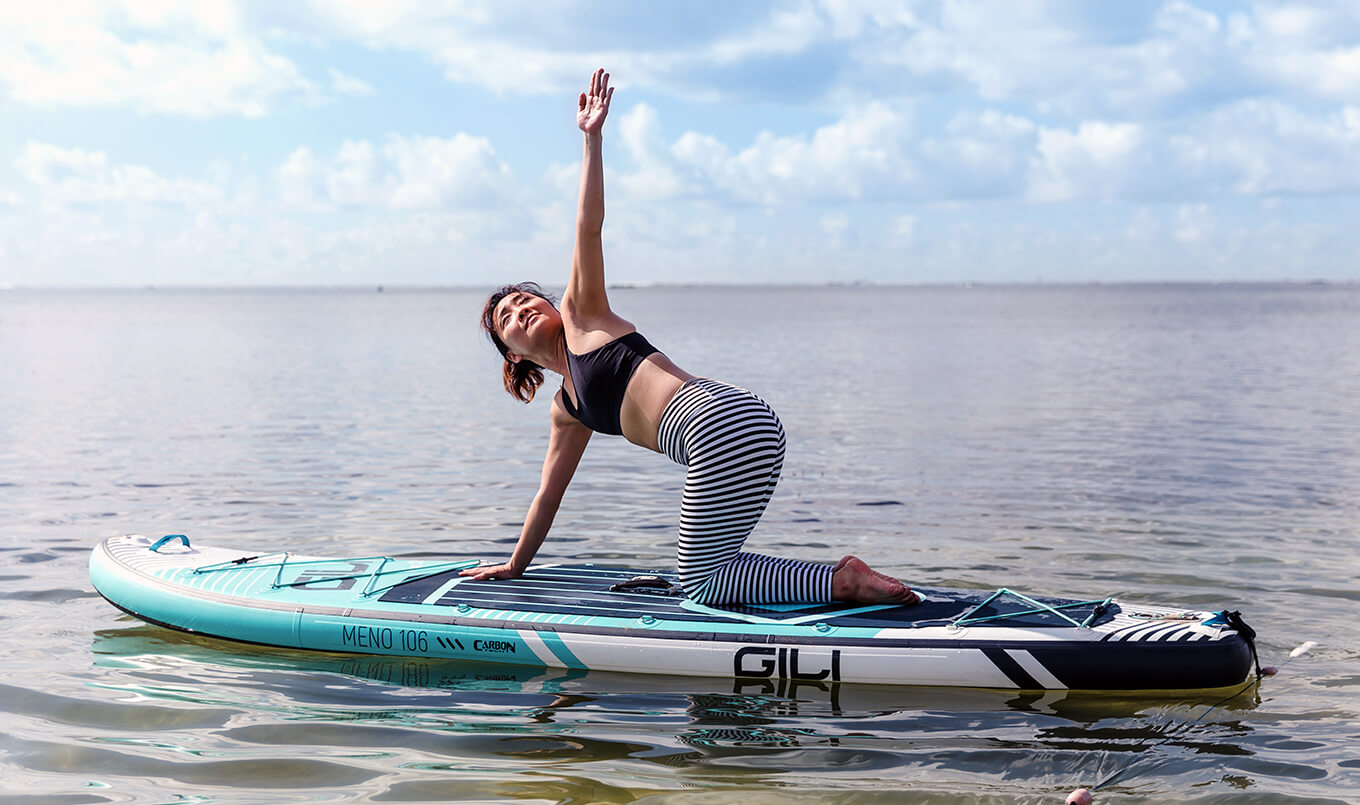
Features:
The Meno series are our widest SUPs, and are the most stable! Great for SUP yoga and the whole family, the 10'6 and 11'6 Meno feature a carbon fiber rail for added rigidity. These boards inflate twice as quickly with the dual chamber pump, and feature a host of premium accessories. The rolling bag takes a load off your shoulders, and the 5-piece fin kit has you ready for any water condition and depth.
Features:
Designed for longer SUP journeys, the Adventure can do it all. If you want a board that can paddle long distance and you can also practice SUP Yoga on, grab the Adventure. With front and rear oversized bungees, you'll have room to store your paddle plus some extra gear. Now available in 11' or 12' options, the 11' option is best if you're going to use it for yoga.
Features:
The GILI AIR is the best inflatable paddle board we could make at an entry-level price. Super light, but wide and stable enough for yoga. We've included our staple extra-large, soft traction pads for a comfortable yoga surface, and you can store all your gear with the oversized front 3-point bungee. Looking for your first SUP - look no further!
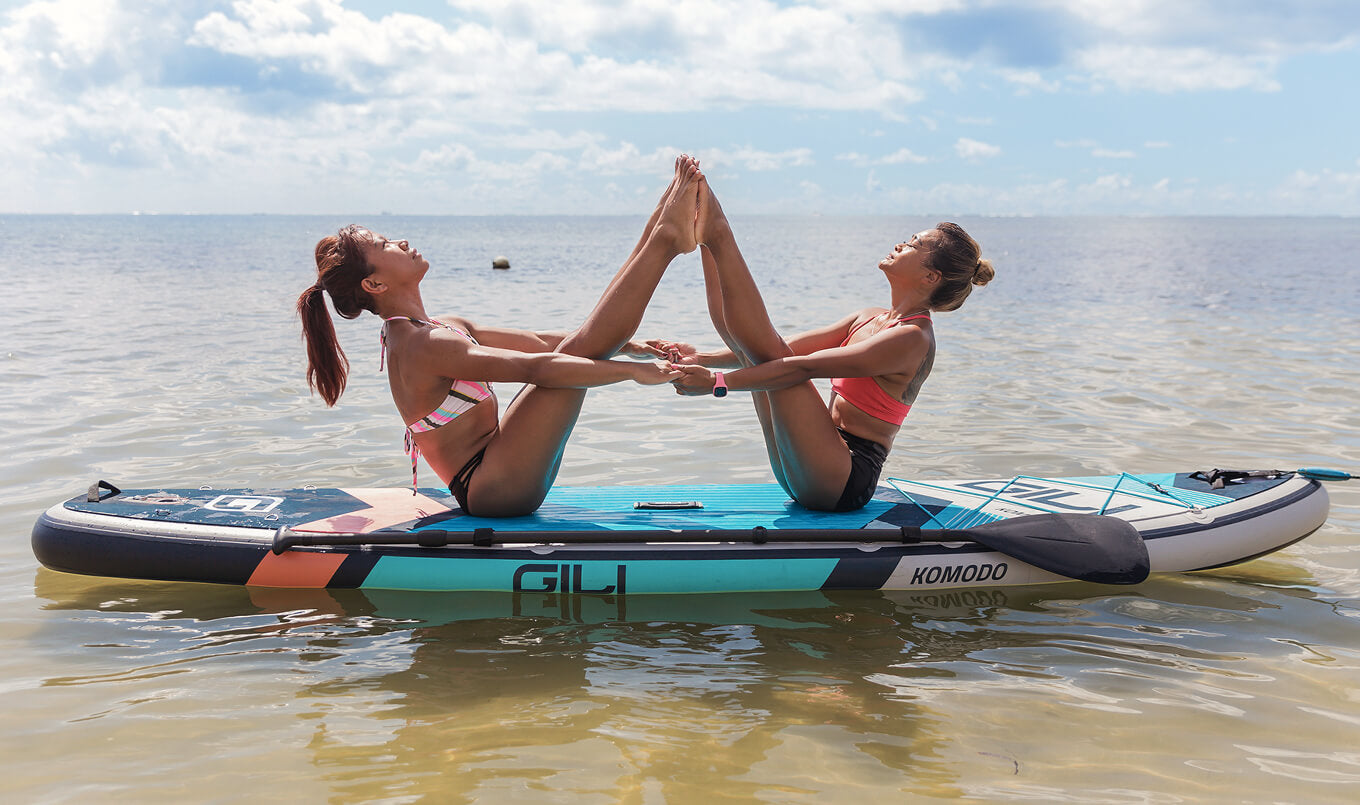
Paddle board yoga clothing isn’t too different from what you would wear paddle boarding for a typical day of SUP. It’s much like what you’d wear to any type of yoga class, with a bit of extra preparation for the sunshine and water. Opt for water-resistant clothes if you can. Remember that layers are your friend and make sure anything you wear can stay in place during upside-down poses like downward dog!
Ready to meet like-minded SUP yogis? Time to try SUP yoga classes!
Most SUP hotspots in the US are home to at least one SUP yoga studio, if not more. You’ll usually be able to find regular classes that meet weekly or even several times a week. In most SUP yoga classes, you’ll begin with a warm-up. The class will head to a peaceful spot to “park” your boards for class. You’ll move through breathing, flowing, and popular poses, with your instructor providing any guidance you need. If it’s your first class, remember: you likely won’t be the only first-timer or beginner!
Of course, the easiest method to find a SUP yoga class near you is simply tapping into online resourcesh. If you can’t turn up any results, ask your local SUP rental company. They’ll know the local SUP yoga scene and can recommend the best classes. You can also check Meetup.com or local Instagram hashtags. And of course, if you ever see someone practicing yoga on their SUP, ask them - they’ll probably be happy to help!
Classes are fun, but they’re not the only way to do SUP yoga. We recommend taking at least a few classes at some point to hone your technique and meet fellow SUP yogis. However, (and this is a big however), you absolutely don’t need to be part of a SUP yoga class to practice. Don’t be afraid to challenge yourself to learn the basics on your own and get out on the water any time you need a bit more calm in your life.
You can practice this sample SUP routine out on the water. Click here to download (PDF) a printable version to use however you like! Laminate it and take it with you, teach it at your school - however you'd like to use it!

Whether you’re starting as a SUP fan, an avid land yogi, or both, SUP yoga is an incredibly enriching way to spend time on the water. You’ll breathe in deep amid the fresh outdoor air, you’ll work muscles you never even knew you had, and you’ll get to conquer a thrilling new challenge. It’s the perfect way to get outside on a Saturday morning or forget the stresses of a long day in the evening. So are you ready to get started? Namaste, yogis!
Comments will be approved before showing up.